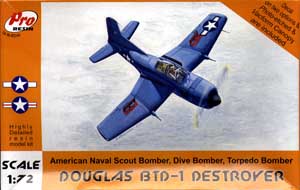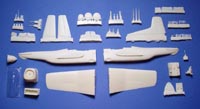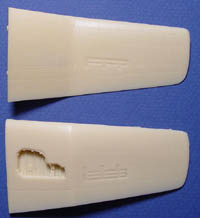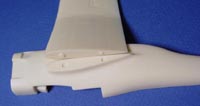Pro Resin 1/72nd Douglas BTD-1 "Destroyer"
|
 |
History
The ill-starred Douglas Destroyer
was originally designed as a two-seat scout/dive bomber meant to replace
the SBD Dauntless. A sturdy, gull-winged airplane powered by a Wright
R-3350 engine, the XSB2D-1 first flew in April 1943. When the Navy changed
its requirements to stipulate a single-seat dive and torpedo bomber, Douglas
reconfigured the Destroyer into the single-seat BTD-1. Though 28 BTD-1s
were built, the type never entered operational service. However, the BTD-1's
design led to the successful AD Skyraider, rugged workhorse of the Korean
and Vietnam Wars. Only one BTD-1 survives today; after many years of display
at Florence, SC, it is now undergoing restoration at the Wings of Eagles
museum at Elmira-Corning, NY.
Pro Resin Models, which recently introduced an injection-molded series
of Curtiss Jenny biplanes in their Olimp line, has done a series of Destroyers
in its Pro Resin line. These kits include the original XSB2D-1, the BTD-1,
and the hybrid jet/prop XBTD-2. For those who can't get enough of interesting
but obscure experimental and short-lived types, the Destroyer kits are
good news indeed.
 Pro
Resin's BTD-1 represents an aircraft with a three-bladed prop and the
big prop spinner (some pictures of BTD-1s show them with four-blade props
with small spinners). The kit consists of 46 resin parts, 18 photoetched
parts, a single vac-formed canopy, a film underlay for the instrument
panel, and a decal sheet. Pro
Resin's BTD-1 represents an aircraft with a three-bladed prop and the
big prop spinner (some pictures of BTD-1s show them with four-blade props
with small spinners). The kit consists of 46 resin parts, 18 photoetched
parts, a single vac-formed canopy, a film underlay for the instrument
panel, and a decal sheet.  The
kit is broken down in the usual manner, with separate fuselage halves
and a conventional wing join. The wings are well-cast single-piece units
with very good wheel well detail and thin trailing edges. All parts feature
finely scribed panel lines. My sample had several air bubbles on the bottom
of the fuselage, and the front surfaces of each wing also had many tiny
bubbles; some judicious application of Mr. Surfacer should fix those.
A quick dry-fit showed no major problems, although the mating surfaces
of each fuselage half will require careful sanding to knock off some goofy
raised areas, probably from where the molds met. The
kit is broken down in the usual manner, with separate fuselage halves
and a conventional wing join. The wings are well-cast single-piece units
with very good wheel well detail and thin trailing edges. All parts feature
finely scribed panel lines. My sample had several air bubbles on the bottom
of the fuselage, and the front surfaces of each wing also had many tiny
bubbles; some judicious application of Mr. Surfacer should fix those.
A quick dry-fit showed no major problems, although the mating surfaces
of each fuselage half will require careful sanding to knock off some goofy
raised areas, probably from where the molds met.  The
fuselage wing roots feature little holes for pins on the ends of the wings.
However, the wings appear to mount to these holes about 1 mm too far back!
The wings also don't quite fit flush, so some work with files and sanding
sticks will save lots of filling later on. No engine detail is present
inside the massive one-piece cowl. This isn't a problem if you use the
kit-supplied prop, but if you want to build yours as one of the aircraft
with the four-blade prop and small sinner, you'll need to figure out a
way to represent an engine and the different prop. Even with this huge
casting up front, you'll probably need a good bit of weight to keep the
finished model on its nose gear. The
fuselage wing roots feature little holes for pins on the ends of the wings.
However, the wings appear to mount to these holes about 1 mm too far back!
The wings also don't quite fit flush, so some work with files and sanding
sticks will save lots of filling later on. No engine detail is present
inside the massive one-piece cowl. This isn't a problem if you use the
kit-supplied prop, but if you want to build yours as one of the aircraft
with the four-blade prop and small sinner, you'll need to figure out a
way to represent an engine and the different prop. Even with this huge
casting up front, you'll probably need a good bit of weight to keep the
finished model on its nose gear.
 Detail
of the kit is good. The resin cockpit tub features no console detail;
as is usual on these limited-run kits, it's supplied on the photoetched
sheet. The landing gear doors are supplied in resin, and are nicely detailed,
but one wonders how they'll fare over time. The resin dive brake frames
didn't survive the trip well, and were smashed to pieces in my kit (no
hassle, since I plan to build this kit with the dive brakes stowed). The
resin landing gear struts will probably not stand up under all this weight,
so consider drilling them through and implanting brass rod. The photoetched
sheet is thin but nicely done, with cowl flaps, dive brakes, interior
details and other fine details. There's only one vac-formed canopy in
the kit, and its cut line is a little soft, so be very careful when you
cut it out and fit it to the model. Detail
of the kit is good. The resin cockpit tub features no console detail;
as is usual on these limited-run kits, it's supplied on the photoetched
sheet. The landing gear doors are supplied in resin, and are nicely detailed,
but one wonders how they'll fare over time. The resin dive brake frames
didn't survive the trip well, and were smashed to pieces in my kit (no
hassle, since I plan to build this kit with the dive brakes stowed). The
resin landing gear struts will probably not stand up under all this weight,
so consider drilling them through and implanting brass rod. The photoetched
sheet is thin but nicely done, with cowl flaps, dive brakes, interior
details and other fine details. There's only one vac-formed canopy in
the kit, and its cut line is a little soft, so be very careful when you
cut it out and fit it to the model.
 Decals
give the builder two options: the first BTD-1 in its tri-color 1943 scheme,
and a BTD-1 of the Naval Air Test Center in 1947 in an overall Glossy
Sea Blue scheme. If these decals are like those in many Eastern European
kits, they'll stick promptly to the first surface they meet, and will
need to have a saliva undercoat (ewww!) if you want to move them around
on the model. Separate red bars are provided for the postwar national
insignia. The decals appear well-printed, with no color or registration
issues worth noting. Decals
give the builder two options: the first BTD-1 in its tri-color 1943 scheme,
and a BTD-1 of the Naval Air Test Center in 1947 in an overall Glossy
Sea Blue scheme. If these decals are like those in many Eastern European
kits, they'll stick promptly to the first surface they meet, and will
need to have a saliva undercoat (ewww!) if you want to move them around
on the model. Separate red bars are provided for the postwar national
insignia. The decals appear well-printed, with no color or registration
issues worth noting.
Pro Resin's BTD-1 looks like a nice, well-engineered resin kit, and those
who are used to short-run multimedia kits should find no surprises. No
accuracy problems are readily apparent in comparison to photographs. It
should make for an unusual, but very pleasant, build.
My thanks to Matt Bittner for forwarding this review sample, supplied
by Pro Resin. |
|
